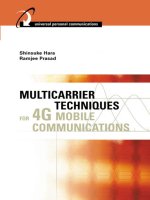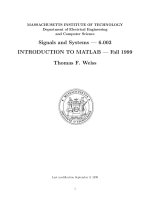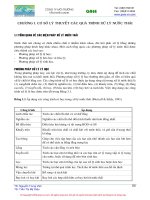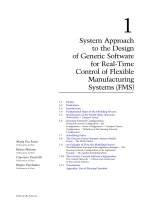Tài liệu Multicarrier Techniques for 4G Mobile Communications P1 docx
Bạn đang xem bản rút gọn của tài liệu. Xem và tải ngay bản đầy đủ của tài liệu tại đây (854.38 KB, 40 trang )
TEAMFLY
Team-Fly
®
Multicarrier Techniques for 4G Mobile
Communications
The Artech House Universal Personal
Communications Series
Ramjee Prasad, Series Editor
CDMA for Wireless Personal Communications, Ramjee Prasad
IP/ATM Mobile Satellite Networks, John Farserotu and Ramjee Prasad
Multicarrier Techniques for 4G Mobile Communications, Shinsuke Hara
and Ramjee Prasad
OFDM for Wireless Multimedia Communications, Richard van Nee and
Ramjee Prasad
Radio over Fiber Technologies for Mobile Communications Networks,
Hamed Al-Raweshidy and Shozo Komaki, editors
Simulation and Software Radio for Mobile Communications,
Hiroshi Harada and Ramjee Prasad
TDD-CDMA for Wireless Communications, Riaz Esmailzadeh and
Masao Nakagawa
Technology Trends in Wireless Communications, Ramjee Prasad and
Marina Ruggieri
Third Generation Mobile Communication Systems, Ramjee Prasad,
Werner Mohr, and Walter Konha
¨
user, editors
Towards a Global 3G System: Advanced Mobile Communications in Europe,
Volume 1, Ramjee Prasad, editor
Towards a Global 3G System: Advanced Mobile Communications in Europe,
Volume 2, Ramjee Prasad, editor
Universal Wireless Personal Communications, Ramjee Prasad
WCDMA: Towards IP Mobility and Mobile Internet, Tero Ojanpera
¨
and
Ramjee Prasad, editors
Wideband CDMA for Third Generation Mobile Communications,
Tero Ojanpera
¨
and Ramjee Prasad, editors
Wireless IP and Building the Mobile Internet, Sudhir Dixit and
Ramjee Prasad, editors
WLAN Systems and Wireless IP for Next Generation Communications,
Neeli Prasad and Anand Prasad, editors
WLANs and WPANs towards 4G Wireless, Ramjee Prasad and Luis Mun
˜
oz
Multicarrier Techniques for 4G Mobile
Communications
Shinsuke Hara
Ramjee Prasad
Artech House
Boston
•
London
www.artechhouse.com
Library of Congress Cataloging-in-Publication Data
Hara, Shinsuke.
Multicarrier techniques for 4G mobile communications / Shinsuke Hara, Ramjee
Prasad.
p. cm. — (Artech House universal personal communications series)
Includes bibliographical references and index.
ISBN 1-58053-482-1 (alk. paper)
1. Universal Mobile Telecommunications System. 2. Carrier waves.
I. Prasad, Ramjee. II. Title. III. Series.
TK5103.4883.H37 2003
621.382—dc21 2003048095
British Library Cataloguing in Publication Data
Hara, Shinsuke
Multicarrier techniques for 4G mobile communications. — (Artech House universal
personal communications series)
1. Mobile communication systems
I. Title II. Prasad, Ramjee
621.3’8456
ISBN 1-58053-482-1
Cover design by Igor Valdman
2003 Shinsuke Hara and Ramjee Prasad.
All rights reserved.
All rights reserved. Printed and bound in the United States of America. No part of this book
may be reproduced or utilized in any form or by any means, electronic or mechanical,
including photocopying, recording, or by any information storage and retrieval system, without
permission in writing from the publisher.
All terms mentioned in this book that are known to be trademarks or service marks have
been appropriately capitalized. Artech House cannot attest to the accuracy of this information.
Use of a term in this book should not be regarded as affecting the validity of any trademark
or service mark.
International Standard Book Number: 1-58053-482-1
Library of Congress Catalog Card Number: 2003048095
10987654321
To my parents Kokichi and Kazuko, to my wife Yoshimi, and to our sons
Tomoyuki and Tomoharu
—Shinsuke Hara
To my wife Jyoti, to our daughter Neeli, to our sons Anand and Rajeev,
and to our granddaughters Sneha and Ruchika
—Ramjee Prasad
Contents
Preface xv
Acknowledgments xvii
1 Introduction 1
1.1 Mobile Communications Systems: Past,
Present, and Future 1
1.2 Toward 4G Systems 2
1.3 Multicarrier Techniques for 4G Systems 7
1.4 Preview of the Book 8
References 10
2 Characteristics of Multipath Fading
Channels 13
2.1 Introduction 13
2.2 Rayleigh and Ricean Fading Channels 14
2.3 Multipath Delay Profile 18
vii
viii Multicarrier Techniques for 4G Mobile Communications
2.4 Frequency Selective and Frequency
Nonselective Fading Channels 19
2.5 Spaced-Time Correlation Function 20
2.6 Time Selective and Time Nonselective Fading
Channels 21
2.7 Examples of Multipath Fading Channels 22
References 26
3 Principle and History of MCM/OFDM 27
3.1 Introduction 27
3.2 Origin of OFDM 27
3.3 Use of Discrete Fourier Transform 30
3.4 Insertion of Cyclic Prefix for Current Form of
OFDM 33
3.5 Conclusions 39
References 41
4 OFDM Characteristics 43
4.1 Introduction 43
4.2 Radio Channel Model 44
4.3 Bit Error Rate in AWGN Channel 46
4.4 Bit Error Rate of CPSK-Based OFDM System
in Rayleigh Fading Channels 49
4.5 Bit Error Rate of DPSK-Based OFDM
System in Rayleigh Fading Channels 49
4.5.1 Theoretical Bit Error Rate Analysis 50
ix
Contents
4.5.2 Bit Error Rate in Frequency Selective and
Time Selective Rayleigh Fading Channels 52
4.5.3 Optimum Number of Subcarriers and
Optimum Length of Guard Interval 56
4.5.4 Numerical Results and Discussions 59
4.6 Robustness Against Frequency Selective
Fading 61
4.7 Robustness Against Man-Made Noises 63
4.7.1 Generalized Shot Noise Channel 64
4.7.2 Bit Error Rate of SCM in GSN Channel 65
4.7.3 Bit Error Rate of OFDM in GSN Channel 67
4.7.4 Numerical Results and Discussions 69
4.8 Sensitivity to Frequency Offset 72
4.8.1 Bit Error Rate in Frequency Selective and
Time Selective Rayleigh Fading Channel with
Frequency Offset 74
4.8.2 Numerical Results and Discussions 77
4.9 Sensitivity to Nonlinear Amplification 79
4.9.1 Simbo’s Method 79
4.9.2 Numerical Results and Discussions 82
4.10 Sensitivity to A/D and D/A Resolutions 86
4.11 Conclusions 88
References 93
Appendix 4A 95
Reference 96
Appendix 4B 96
5 Pilot-Assisted DFT Window Timing/
Frequency Offset Synchronization and
Subcarrier Recovery 99
5.1 Introduction 99
x Multicarrier Techniques for 4G Mobile Communications
5.2 Pilot-Assisted DFT Window Timing/
Frequency Offset Estimation Method 101
5.2.1 Principle of DFT Window Timing Estimation 101
5.2.2 Principle of Frequency Offset Estimation 105
5.2.3 Spectral Property of Pilot Symbol 106
5.2.4 Performance of DFT Window Timing
Estimator 107
5.2.5 Performance of Frequency Offset Estimator 110
5.3 Pilot-Assisted DFT Window Timing
Synchronization and Subcarrier Recovery
Method 111
5.3.1 Time Domain Pilot-Assisted DFT Window
Timing Synchronization and Subcarrier
Recovery Method 111
5.3.2 Frequency Domain Pilot-Assisted Subcarrier
Recovery Method 115
5.3.3 Numerical Results and Discussions 116
5.4 Chaotic Pilot Symbol Generation Method 121
5.5 Conclusions 123
References 125
6 Blind Maximum Likelihood-Based Joint DFT
Window Timing/Frequency Offset/ DFT
Window Width Estimation 127
6.1 Introduction 127
6.2 System Model 128
6.3 Maximum Likelihood Parameter Estimation
for Cyclostationary Signal 129
6.4 Numerical Results and Discussions 134
6.5 Conclusions 135
References 139
TEAMFLY
Team-Fly
®
xi
Contents
7 Coded OFDM Scheme to Gain Frequency
Diversity Effect 141
7.1 Introduction 141
7.2 Convolutional Encoding/Viterbi Decoding 142
7.3 Symbol Interleaved Coded OFDM Scheme 143
7.4 Bit Interleaved Coded OFDM Scheme 146
7.5 Numerical Results and Discussions 149
7.6 Conclusions 156
References 158
8 Applications of OFDM 159
8.1 Introduction 159
8.2 Digital Broadcasting 159
8.2.1 Digital Audio Broadcasting 159
8.2.2 Terrestrial Digital Video Broadcasting 160
8.2.3 Terrestrial Integrated Services Digital
Broadcasting 161
8.3 5 GHz-Band Wireless LANs 162
8.4 Others 165
8.4.1 IEEE 802.11g 165
8.4.2 IEEE 802.11h 165
8.4.3 IEEE 802.16a 166
8.5 Conclusions 167
References 167
9 Combination of OFDM and CDMA 169
9.1 Introduction 169
9.2 Channel Model 170
xii Multicarrier Techniques for 4G Mobile Communications
9.3 DS-CDMA System 171
9.3.1 DS-CDMA Transmitter 171
9.3.2 DS-CDMA Receiver 173
9.3.3 Bit Error Rate Analysis 175
9.4 MC-CDMA System 176
9.4.1 MC-CDMA Transmitter 176
9.4.2 MC-CDMA Receiver 179
9.4.3 Bit Error Rate Analysis 183
9.4.4 Design of MC-CDMA System 186
9.4.5 Head/Tail Guard Interval Insertion Method 188
9.4.6 Bit Error Rate of MC-CDMA System 191
9.4.7 Sliding DFT-Based Subcarrier Recovery
Method 194
9.5 Conclusions 200
References 200
10 Future Research Directions 203
10.1 Introduction 203
10.2 Where Will 4G Systems Come From? 204
10.3 Variants Based on MC-CDMA Scheme 204
10.3.1 OFCDM System 204
10.3.2 Other Variant Based on MC-CDMA Scheme 209
10.4 OFDM Adaptive Array Antennas 211
10.4.1 Principle of Adaptive Array Antenna 211
10.4.2 Post-FFT and Pre-FFT Type OFDM
Adaptive Array Antennas 211
10.4.3 Weight-Per-User and Weight-Per-Path Type
OFDM Adaptive Array Antennas 213
10.5 MIMO-OFDM 215
xiii
Contents
10.6 Linear Amplification of OFDM Signal with
Nonlinear Components 216
10.7 Conclusions 218
References 220
List of Acronyms 223
About the Authors 227
Index 231
Preface
yada
¯
samharate ca
¯
yam
ku
¯
rmo ′nga
¯
nı
¯
va sarvas
´
ah
indriya
¯
nı
¯
ndriya
¯
rthebhyas
tasya prajn
˜
a
¯
pratisthita
¯
‘‘One who is able to withdraw his senses from sense objects, as the
tortoise draws its limbs within the shell, is firmly fixed in perfect
consciousness.’’
—The Bhagvad Gita (2.58)
At recent major international conferences on wireless communications,
there have been several sessions on beyond third generation (3G) or fourth
generation (4G) mobile communications systems, where modulation/demod-
ulation and multiplexing/multiple access schemes related to multicarrier
techniques have drawn a lot of attention. We often met at the conference
venues and realized that no book covered the basics of multicarrier techniques
to recent applications aiming at the 4G systems. Therefore, we decided to
write a book on multicarrier techniques for 4G mobile communications
systems.
xv
xvi Multicarrier Techniques for 4G Mobile Communications
Figure P.1 illustrates the coverage of the book.
This book provides a comprehensive introduction to multicarrier tech-
niques including orthogonal frequency division multiplexing (OFDM), put-
ting much emphasis on the analytical aspects by introducing basic equations
with derivations.
This book will help solve many problems encountered in research and
development of multicarrier-based wireless systems. We have tried our best
to make each chapter comprehensive. We cannot claim that this book is
errorless. Therefore, we would really appreciate it if readers would provide
us with any comments to improve the text and correct any errors.
Figure P.1 Illustration of the coverage of the book. The number in branches denotes the
chapter of the book.
Acknowledgments
The material in this book is based on research activities at Osaka University
in Japan, the Department of Communication Technology at Aalborg Univer-
sity in Denmark, and Delft University of Technology in the Netherlands. The
authors would like to thank Professor Norihiko Morinaga (Osaka University),
who gave Shinsuke a chance to work with Ramjee in the Netherlands in
1995–1996. They also wish to thank Dr. Jean-Paul Linnartz (Philips National
Laboratory), who also gave Shinsuke a chance to do research in the Nether-
lands. Their heartfelt gratitude also goes to Professors Seiichi Sampei and
Shinichi Miyamoto (Osaka University), who kindly took care of Shinsuke’s
students during his absence.
They are deeply indebted to Professor Minoru Okada (Nara Institute
of Science and Technology in Japan) and Dr. Yoshitaka Hara (Information
Technology R&D Center at Mitsubishi Electric Corporation in Japan) for
their discussion, interaction, and friendship with Shinsuke over the years.
The material in this book has benefited greatly from the inputs of the
following many brilliant students who have worked with us on the topic:
Kazuyasu Yamane, Kiyoshi Fukui, Ikuo Yamashita, Masutada Mouri, Tai
Hin Lee, Frans Kleer, Daichi Imamura, Masaya Nakanomori, Shuichi Hane,
Shigehiko Tsumura, and Montee Budsabathon.
Last but not the least, the authors would like to express their apprecia-
tion for the support Junko Prasad provided in finishing the book.
xvii
1
Introduction
1.1 Mobile Communications Systems: Past, Present, and
Future
There has been a paradigm shift in mobile communications systems every
decade. The first generation (1G) systems in the 1980s were based on analog
technologies, and the second generation (2G) systems in the 1990s, such as
Global Systems for Mobile Telecommunications (GSM) [1], Personal Digital
Cellular (PDC) [2], and Interim Standard (IS)-95 [3], on digital technologies
for voice-oriented traffic. The 3G systems are also based on digital technolo-
gies for mixed voice, data, and multimedia traffic and mixed-circuit and
packet-switched network [4, 5]. The first 3G system was introduced in
October 2001 in Japan [6].
Figure 1.1 shows a rough sketch of present and future mobile communi-
cations systems. As an evolutional form of mobile phone systems, Interna-
tional Mobile Telecommunications (IMT)-2000 [4, 5], which corresponds
to 3G systems, aims to support a wide range of multimedia services from
voice and low-rate to high-rate data with up to at least 144 Kbps in vehicular,
384 Kbps in outdoor-to-indoor, and 2 Mbps in indoor and picocell environ-
ments. It provides continuous service coverage in 2-GHz band with code
division multiplexing/code division multiple access (CDM/CDMA) scheme
and supports both circuit-switched and packet-oriented services. Further-
more, high data rate (HDR), which supports a maximum 2.4-Mbps downlink
packet transmission, is proposed [7], and high-speed downlink packet access
(HSDPA), which also aims for more than 2-Mbps throughput, is under
1
2 Multicarrier Techniques for 4G Mobile Communications
Figure 1.1 A rough sketch of present and future mobile communications systems.
standardization in the Third Generation Partnership Project (3GPP) [8].
Both HDR and HSDPA are categorized into enhanced IMT-2000 systems,
which correspond to 3.5G systems.
As a progressive form of wireless local area networks (LANs), high-
rate wireless LANs [9] such as IEEE802.11a [10], high-performance radio
LAN type two (HIPERLAN/2) [11], and multimedia mobile access commu-
nication (MMAC) [12, 13], which are all based on the OFDM technique,
provide data transmission up to 54 Mbps in 5-GHz band. They are mainly
intended for communications between computers in an indoor environment,
although they can support real-time audio and video transmission, and users
are allowed some mobility [14].
1.2 Toward 4G Systems
Long-term researches and developments are usually required to lead a com-
mercial service to success. Now, just coming into the new century, it might
TEAMFLY
Team-Fly
®
3
Introduction
be a good time to start discussions on 4G systems, which may be put in
service around 2010. Indeed, since the beginning of this century, we have
often seen the words ‘‘future generation,’’ ‘‘beyond 3G’’ or ‘‘4G’’ in magazines
on wireless communications [15–19].
According to the Vision Preliminary Draft of New Recommendation
(DNR) of ITU-R WP8F [20, 21], there will be a steady and continuous
evolution of IMT-2000 to support new applications, products, and services.
For example, the capacities of some of the IMT-2000 terrestrial radio inter-
faces are already being extended up to 10 Mbps, and it is anticipated that
these will be extended even further, up to approximately 30 Mbps, by 2005,
although these data rates will be limited only under optimum signal and traffic
conditions. For systems beyond 3G [beyond IMT-2000 in the International
Telecommunication Union (ITU)], there may be a requirement for a new
wireless access technology for the terrestrial component around 2010. This
will complement the enhanced IMT-2000 systems and the other radio sys-
tems with which there is an interrelationship. It is envisaged that these
potential new radio interfaces will support up to approximately 100 Mbps
for high mobility and up to approximately 1 Gbps for low mobility such
as nomadic/local wireless access by around 2010.
The data rate figures are targets for research and investigation on the
basic technologies necessary to implement the vision. The future system
specification and design will be based on the results of the research and
investigations. Due to the high data rate requirements, additional spectrum
will be needed for these new capabilities of systems beyond IMT-2000. The
data rate targets consider advances in technology, and these values are expected
to be feasible from a technology perspective in the time frame of investigation
and development of the new capabilities of systems beyond IMT-2000.
In conjunction with the future development of IMT-2000 and systems
beyond IMT-2000, there will be an increasing relationship between radio
access and communication systems, such as wireless personal area networks
(PANs), LANs, digital broadcast, and fixed wireless access.
Based on today’s envisaged service requirements, traffic expectations,
and radio access technologies, ITU-R is working on a potential system
architecture, according to Figures 1.2 through 1.4.
In this context, low mobility covers pedestrian speed (≈3km/h), medium
mobility corresponds to limited speed as for cars within cities (≈50-60 km/h),
high mobility covers high speed as on highways or with fast trains (≈60
km/h to 250 km/h, or even more). The degree of mobility is basically linked
to the cell size in a cellular system, as well as to system capacity. In general,
the cell size in a cellular system has to be greater for a higher degree of
mobility in order to limit the handover load in the network.
4 Multicarrier Techniques for 4G Mobile Communications
Figure 1.2 System capabilities for systems beyond third generation. (After: [20].)
Figure 1.3 Seamless future network, including a variety of interworking access systems.
(After: [20].)
5
Introduction
Figure 1.4 Layered structure of seamless future network with primarily allocated systems. (After: [20].)
6 Multicarrier Techniques for 4G Mobile Communications
Different complementary access schemes will be part of systems beyond
IMT-2000. The different access systems are cooperating in terms of vertical
handover and seamless service provision. Reconfigurable terminal devices
and network infrastructure will be an essential part of such architecture.
Such a concept of heterogeneous networks enables a migration and evolution
path for network operators from today’s networks to systems beyond IMT-
2000 by reusing deployed investment. New access components can be added
where and when needed from economic reasons. This ensures the requested
scalability of the system according to Figure 1.5.
Possible new radio interface components are part of the concept. The
different access systems will use already-allocated and identified frequency
bands and potential new frequency bands for the new elements. Therefore,
no direct interference between different technologies has to be expected. All
access systems will be connected to an Internet Protocol (IP)-based network.
Discussions are ongoing as to whether there should be a distinction between
radio access and core network in the future.
From today’s perspective, ITU-R expects the start of system standardiza-
tion after WRC’07 with respect to identified spectrum bands and an initial
deployment of systems beyond IMT-2000 after 2010.
The future system will comprise available and evolving access technolo-
gies. In addition, new radio access technologies with high carrier data rate
for the wireless nomadic case with low mobility and for the cellular case
with high mobility are envisaged. The data rate requirement for the cellular
case is a big challenge from the technological perspective and with respect
to the availability of sufficient future spectrum. Figure 1.6 shows the time
plan for the systems beyond IMT-2000.
Figure 1.5 Inhomogeneous traffic or system capacity demand in deployment area.
(After: [20].)









